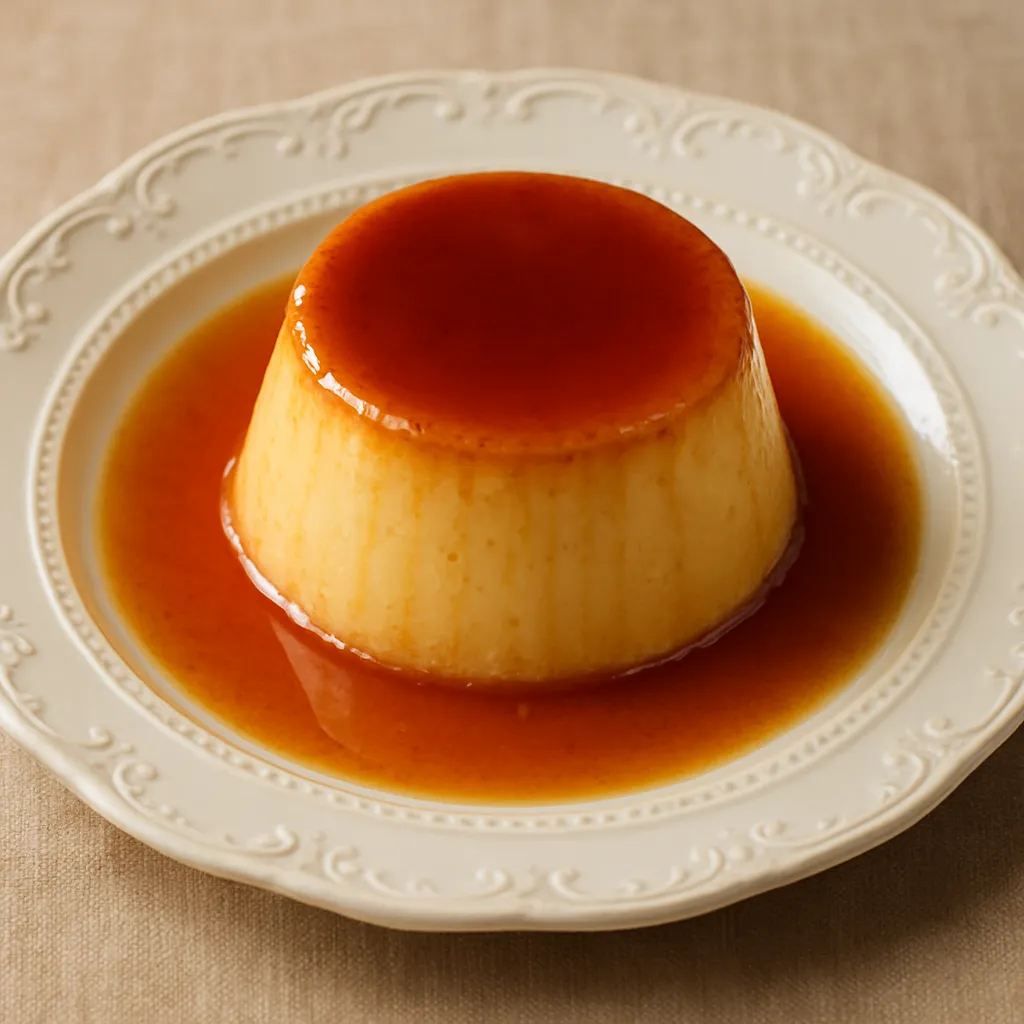 Save
Save
This silky smooth Spanish Flan (Flan de Huevo) transforms just a handful of basic ingredients into a decadent dessert that's been stealing the spotlight at my family gatherings for generations. The magic happens as the sweet caramel sauce cascades down the sides of the custard when you flip it onto the serving plate.
I learned to make this flan from my grandmother who insisted on the overnight chill for the best texture. Though I was impatient the first time I made it alone, I've never again skipped that crucial resting period after experiencing the difference in silky texture.
Ingredients
- For the Caramel:
- 1 cup sugar Creates that gorgeous amber sauce that cascades over the flan
- 1/3 cup water Helps the sugar melt evenly without crystallizing
- For the Custard:
- 4 large eggs Provides structure while keeping the custard velvety smooth
- 1 can sweetened condensed milk Adds rich sweetness and creamy texture
- 1 can evaporated milk Creates a silky consistency without being too heavy
- 1 tablespoon vanilla extract Enhances the flavor profile with warmth and depth
Step-by-Step Instructions
- Make the Caramel
- Combine sugar and water in a saucepan over medium heat. Resist the urge to stir. This is critical for preventing sugar crystallization. Instead, gently swirl the pan occasionally as the mixture heats. Watch carefully as the sugar begins to change color, turning from clear to golden and finally to an amber caramel color. This process takes about 8 to 10 minutes, and it can go from perfect to burnt very quickly.
- Pour the Caramel
- Once your caramel reaches that beautiful amber color, immediately remove from heat and carefully pour into your flan mold or individual ramekins. Use oven mitts as the caramel is extremely hot. Quickly but carefully tilt the mold to coat the bottom evenly before the caramel hardens. The caramel will harden rapidly, creating a solid layer that will later melt into sauce. Allow it to cool completely, about 10 minutes.
- Prepare the Custard
- In a large bowl, gently whisk the eggs without incorporating too much air. We want a smooth custard, not a foamy one. Add the sweetened condensed milk and evaporated milk, continuing to whisk gently. Finish with the vanilla extract, mixing until just combined. The mixture should be completely smooth and a pale yellow color.
- Strain for Silkiness
- Pour the custard mixture through a fine mesh sieve into another bowl. This crucial step removes any egg fragments or lumps that would disrupt the smooth texture of your flan. Work slowly and use a spatula to press the mixture through if needed.
- Set Up Water Bath
- Place your caramel lined flan mold into a larger baking dish. Pour the strained custard mixture over the hardened caramel. Then carefully fill the outer baking dish with hot water until it reaches halfway up the sides of your flan mold. This water bath ensures gentle, even cooking and prevents the custard from curdling.
- Bake to Perfection
- Bake in a preheated 325°F oven for 50 to 60 minutes. The flan is done when it still has a slight wobble in the center but a knife inserted near the edge comes out clean. The center will continue to set as it cools. Avoid overbaking as this creates a rubbery texture rather than silky smooth.
- Cooling Process
- Remove from the oven but leave the flan in the water bath for 10 minutes. This gentle cooling prevents the flan from cracking. Then remove from the water bath and cool completely at room temperature before covering and refrigerating for at least 4 hours, but preferably overnight.
- Unmold and Serve
- Run a thin knife around the edge of the chilled flan to loosen it from the mold. Place your serving plate over the top of the mold, then quickly flip both over together. Gently wiggle and lift the mold allowing gravity to release the flan. The caramel will flow over and around the flan, creating a beautiful sauce.
 Save
Save
My absolute favorite moment is watching guests take their first bite. The way their eyes widen as they experience that perfect balance of creamy custard and bitter caramel sauce makes all the waiting worthwhile. This dessert proves that patience truly is rewarded.
The Perfect Caramel Technique
Creating the perfect caramel for flan can be intimidating for beginners, but it's absolutely achievable with patience. Look for visual cues rather than timing. The sugar syrup will first become clear, then take on a light golden hue, gradually darkening to amber. The darker the caramel, the more complex and slightly bitter the flavor becomes, which beautifully balances the sweet custard. If you're nervous, use a light colored pan which makes it easier to monitor the changing colors. Remember, the caramel continues cooking even after you remove it from heat, so act quickly when pouring.
Troubleshooting Common Issues
Bubbles in your flan usually indicate the custard was whisked too vigorously, incorporating too much air. Always whisk gently and strain thoroughly. If your flan has a curdled or eggy texture, the most likely culprit is overcooking or using too high heat. The water bath is crucial for maintaining gentle heat. Cracks on the surface appear when the flan cools too quickly or was overbaked. Cooling in the water bath helps prevent this. Lastly, if your caramel won't release, try dipping the bottom of the mold in warm water for 30 seconds to loosen it.
Cultural Significance
Flan has deep roots in Spanish cuisine, dating back to Roman times when domesticated chickens first made eggs widely available. The addition of caramel came during Moorish occupation of Spain, bringing new techniques for working with sugar. The version with condensed and evaporated milk became popular in the early 20th century, making this luxurious dessert more accessible to home cooks. Traditionally served during celebrations and holidays, flan represents the sweet conclusion to important family gatherings. In modern Spain, almost every region has their own variation, but this classic version remains the gold standard.
Storage and Make Ahead Tips
Flan actually improves with time, making it the perfect make ahead dessert. It can be refrigerated in its mold for up to 3 days before serving. Once unmolded, leftover flan should be covered and can be stored for an additional 2 days, though the presentation won't be as pristine. Flan does not freeze well as the texture becomes grainy upon thawing. If you're serving for a special occasion, make it the day before for optimal flavor development while maintaining that picture perfect appearance when unmolded.
Recipe FAQs
- → How do I know when my Spanish flan is properly cooked?
Your flan is properly cooked when it's set around the edges but still has a slight wobble in the center—similar to gelatin. A knife inserted about an inch from the center should come out clean. Avoid overbaking, as this can cause the flan to become rubbery or develop bubbles.
- → Can I make Spanish flan ahead of time?
Yes! Spanish flan actually benefits from being made ahead. For best results, prepare it 1-2 days before serving and keep refrigerated. This allows the flavors to develop and the caramel to fully infuse into the bottom layer, creating that signature sauce when unmolded.
- → Why did my caramel harden immediately when I poured it into the mold?
This is completely normal and expected. The caramel hardens when it hits the cooler surface of the mold. During baking and cooling, it will gradually liquefy again to create the sauce. Just ensure your mold is at room temperature (not cold) when pouring the hot caramel.
- → What's the best way to unmold Spanish flan without breaking it?
After chilling thoroughly (at least 4 hours or overnight), run a thin knife around the edge of the mold. Place your serving plate on top, then quickly but confidently flip everything over. Hold the mold and plate together and gently shake side to side until you hear the flan release. Lift the mold slowly to allow the caramel to flow over the flan.
- → Can I use different molds for Spanish flan?
Yes, Spanish flan can be made in various molds—a traditional round flan mold, individual ramekins, or even a cake pan. Metal molds conduct heat better for the caramel, but ceramic works well too. If using individual ramekins, reduce the baking time to about 30-40 minutes.
- → Why is my flan bubbling or has holes in it?
Bubbles or holes in flan usually result from whisking the eggs too vigorously (incorporating air) or baking at too high a temperature. To prevent this, whisk gently, strain the custard mixture, and always bake in a water bath at a moderate temperature. The water bath provides gentle, even heat.
